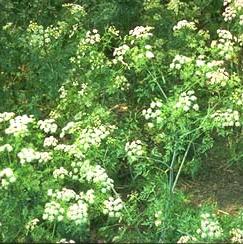Conium maculatum (Poison Hemlock)
 Index
Index
- Distribution
- Description
- How to Distinguish From Other Plants
-
Toxic ingredient: Piperidine Alkaloids
Distribution
Poison hemlock is native to Europe. However, it is now widely distributed across the United States, especially in the Northern states. It is common along roadsides, hiking trails, ditches and field borders.
Description
Poison Hemlock can grow to be about 6 to 10 ft. tall. It has leaves and white flowerheads resembling those of parsnips, carrots, and water hemlock. It has a fleshy, white taproot, a main stem with characteristic light red spots and a disagreeable smell. All plant parts are poisonous. However, the seeds contain the highest concentration of poison. The conium alkaloids are volatile and can even cause toxic reactions when inhaled.

note the characteristic
red mottling on the stems
How to distinguish from other plants
Water hemlock does not have the same main taproot and stem. Instead, water hemlock has a branching, tuberous root stalk similar to that of a dahlia plant. The lower part of the stem of water hemlock is divided into chambers which contain its toxicant. Poison Hemlock is also commonly confused with wild carrot, cow parsnip, etc. Human deaths have occurred from harvesting and consuming the roots as wild carrots or parsnips. The stems should always be checked for red mottling. However, this characteristic is not always readily apparant.
More information describing this plant can be found under Poison Hemlock in the Canadian Poisonous Plants Information System, courtesy of DerekB. Munro.
This series of web pages was created by Yuan-Kuo Chen, an undergraduate student at Cornell University for the AS625 class.
WARNING: These web pages are only meant to be informative. Neither Cornell University nor the author of this site endorse or recommend the use of these plants.
For problems or comments on this web page, contact the Animal Science Webmaster